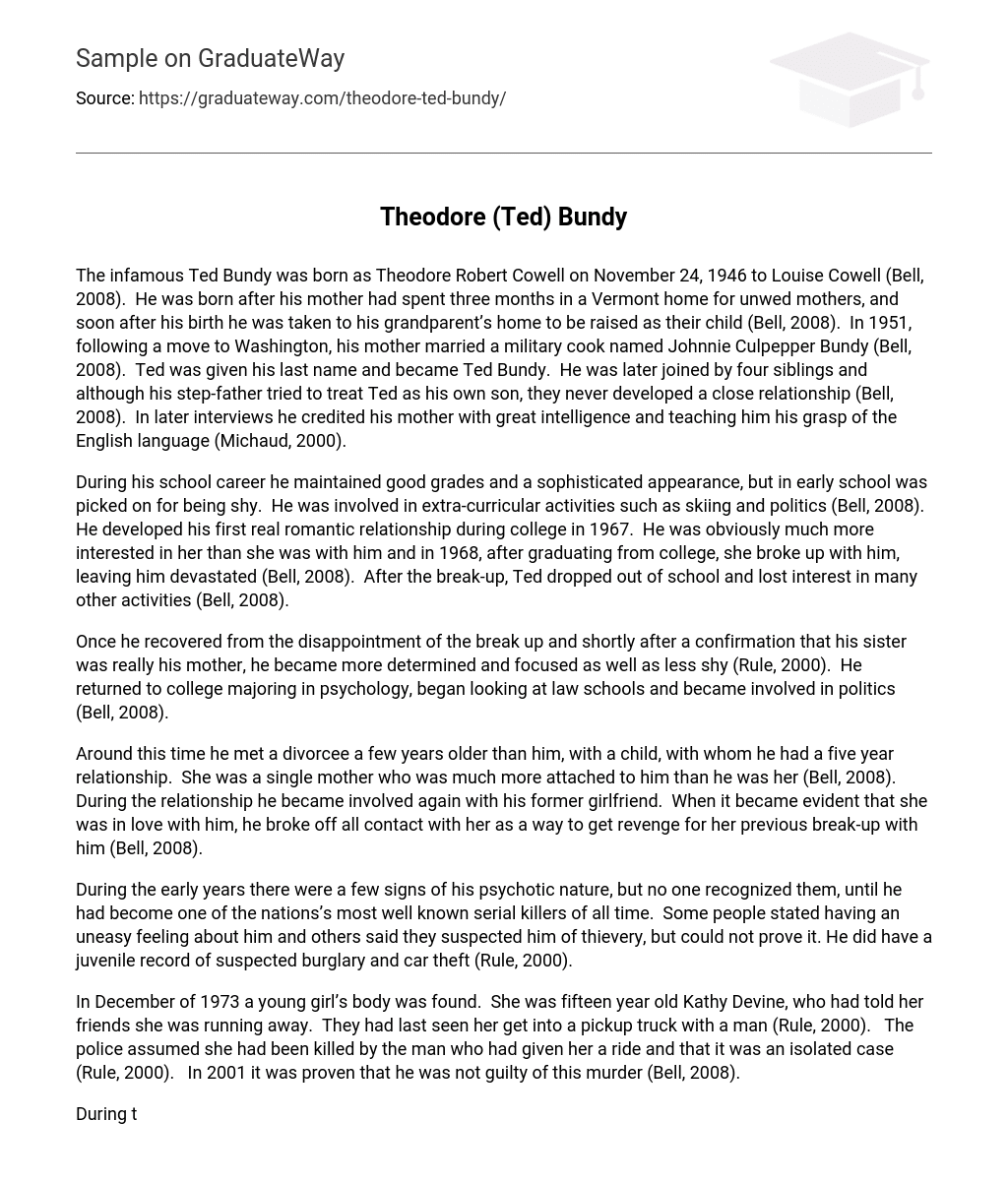The infamous Ted Bundy was born as Theodore Robert Cowell on November 24, 1946 to Louise Cowell (Bell, 2008). He was born after his mother had spent three months in a Vermont home for unwed mothers, and soon after his birth he was taken to his grandparent’s home to be raised as their child (Bell, 2008). In 1951, following a move to Washington, his mother married a military cook named Johnnie Culpepper Bundy (Bell, 2008). Ted was given his last name and became Ted Bundy. He was later joined by four siblings and although his step-father tried to treat Ted as his own son, they never developed a close relationship (Bell, 2008). In later interviews he credited his mother with great intelligence and teaching him his grasp of the English language (Michaud, 2000).
During his school career he maintained good grades and a sophisticated appearance, but in early school was picked on for being shy. He was involved in extra-curricular activities such as skiing and politics (Bell, 2008). He developed his first real romantic relationship during college in 1967. He was obviously much more interested in her than she was with him and in 1968, after graduating from college, she broke up with him, leaving him devastated (Bell, 2008). After the break-up, Ted dropped out of school and lost interest in many other activities (Bell, 2008).
Once he recovered from the disappointment of the break up and shortly after a confirmation that his sister was really his mother, he became more determined and focused as well as less shy (Rule, 2000). He returned to college majoring in psychology, began looking at law schools and became involved in politics (Bell, 2008).
Around this time he met a divorcee a few years older than him, with a child, with whom he had a five year relationship. She was a single mother who was much more attached to him than he was her (Bell, 2008). During the relationship he became involved again with his former girlfriend. When it became evident that she was in love with him, he broke off all contact with her as a way to get revenge for her previous break-up with him (Bell, 2008).
During the early years there were a few signs of his psychotic nature, but no one recognized them, until he had become one of the nations’s most well known serial killers of all time. Some people stated having an uneasy feeling about him and others said they suspected him of thievery, but could not prove it. He did have a juvenile record of suspected burglary and car theft (Rule, 2000).
In December of 1973 a young girl’s body was found. She was fifteen year old Kathy Devine, who had told her friends she was running away. They had last seen her get into a pickup truck with a man (Rule, 2000). The police assumed she had been killed by the man who had given her a ride and that it was an isolated case (Rule, 2000). In 2001 it was proven that he was not guilty of this murder (Bell, 2008).
During the year 1974, however white female college students with long hair began to go missing. The first one reported missing was Lynda Ann Healy, a twenty-one year old psychology major, who reported ski conditions on morning radio. She was taken from her home during the night with only a few blood stains left behind (Bell, 2008). Around the same time as the disappearances and in some cases near the areas where the disappearances occurred, reports began coming in of a man with a cast on either his arm or leg trying to get college girls to assist him with his books (Bell, 2008).
When the girls began to be found dead, a number of witnesses were found with clues about the possible suspect. There was a composite sketch placed in a newspaper drawn of the person seen trying to get assistance from the young women. In addition to the sketch the paper described the suspect as telling one of the dead girls his name was Ted. He was seen near a VW bug, which was listed in the newspaper article. When a good friend of Ted’s girlfriend saw the article, she recognized the suspect as Ted Bundy (Bell, 2008). Ted’s girlfriend called the police when her friend shared the information with her, and she gave more pertinent information later, but it was dismissed. The police pursued what they thought were more likely suspects.
In order to throw off suspicion, he moved around and committed crimes in other states. He was ultimately caught in 1975 and was arrested for burglary. Upon additional investigation he became the primary suspect in some of the murders (Bell, 2008). Ted was set for trial for a number of the murders and subsequently found guilty. He had a brief escape and was recaptured. He was found to be responsible for the deaths of at least thirty-six women and potentially up to a hundred throughout his lifetime. He took some of his secrets to his grave and the true number of victims will never be known. Ted Bundy was put to death by the electric chair on January 24, 1989. After the announcement was made that he was dead, there were a number of cheers from the families of victims.
Resources
- Bell, Rachael. Trutv Crime Library (2008) Retrieved September 2, 2008 from:
- Ted Bundy, notorious serial killer – Crime Library on truTV.com
- Michaud, Stephen and Aynesworth, Hugh. Ted Bundy Conversations With a Killer (2000) Authorlink Press
- Rule, Ann. The Stranger Beside Me (2000). W.W. Norton &Company/New York
- The Stranger Beside Me – Google Book Search





